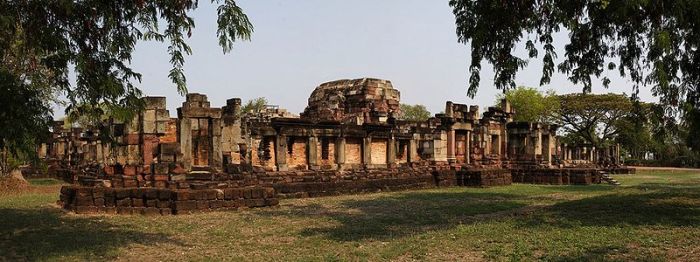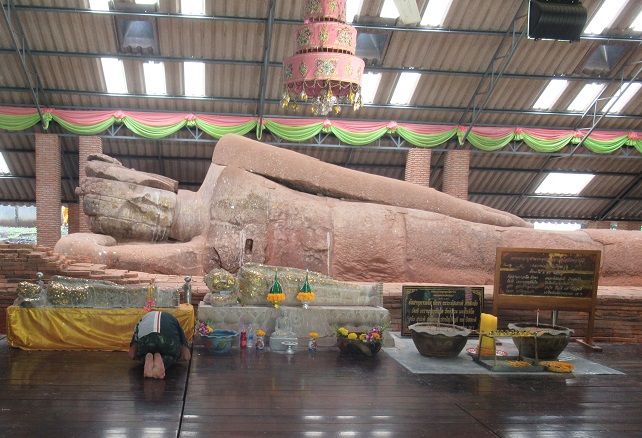A few years ago, this temple used to receive very little attention from travelers. The few people who made it there described it as an unsatisfying jumble of stones in a field. The only detailed attention it received was from French archaeologists, some of whom had written field reports that were sadly opaque to me. However, in recent years the temple has been full restored by the Department of Fine Arts, making it a worthwhile destination for anyone passing through Nakhon Ratchasima Province. While the architecture is neither as dramatic as that of Phanom Rung nor as lyrical as Muang Tam, it is still an impressive 11th century Khmer shrine. What adds considerably to the mystery of the site is a small tower, one of several traces of an early temple on the site, perhaps dating back as far as the 7th century.
Prasat Phnom Wan is located around fifteen kilometres out of the city of Nakhon Ratchasima (formerly Khorat), on the road to Khon Kaen. Even though it has been fully restored, it is still not seem to be on many tour bus itineraries, and we had it to ourselves when we visited during the middle of the week. When you arrive, you will see that the temple is set in an open, grassy area, with shade trees set around the edge of the temple today. There was once a moat around the temple, but only the barest traces of it remain today- a sort of minor depression which you could easily overlook. The outermost part of the complex is the rectangular outer gallery. These consist mostly of a red laterite base, though there is also extensive use of white and pink sandstone, especially in the door jambs and window frames. Even following the restoration, the gallery is far from complete: parts of the walls and the entirely of the roof is missing. Nonetheless, you get a clear impression of the outermost walls of a sacred space.

There are gopuras in each of the outermost four walls, which lead into the inner courtyard. Here you can get your best sense of the gallery, with its narrow passageway and slender sandstone columns. These galleries were notoriously unstable in Angkorean temples, as the ancient Khmers had only invented the corbelled arch, which was very unstable. Therefore, it is not surprising that the gallery here is roofless, bringing to mind the many collapsed galleries at Angkor Archaeological Site, yet it is still an evocative structure, somehow bringing to mind ancient robed figures and smoky Brahmanical rites.
The focus on the inner courtyard is the central sanctuary, which has been extensively renovated over the past few years. It is very easy to distinguish between the original stonework and the modern reconstruction because the new portions were deliberately rebuilt from a very pale sandstone. This has enabled the Department of Fine Arts to restore the original lotus-bud shape of the temple- something which is highly esteemed by Thai visitors- but at the same time it enables visitors to immediately distinguish between the eleventh and twenty-first century stonework.At first I was a little startled by the mottled appearance of the restored temple, but in retrospect I see that the project was well-conceived and executed.

The main is 25 metres tall. While not quite as massive as the main tower at Phimai or Phanom Rung, it is still a monumental structure which rates among the tallest Khmer towers in Thailand. In addition to the main tower, it also consists of a mandapa and connecting antarala, a configuration which also brings to mind the more famous temples of Phimai and Phanom Rung, though the architecture here is a much more modest scale. Perhaps the best position from which to appreciate the whole of the sanctuary is from the southeast: in the foreground is the mandapa with its arched roof, pinkish walls and balustraded windows, and behind it is the pale prang (tower), with its characteristic lotus shape, drawing to mind Angkor Wat. This is perhaps the most impressive silhouette the temple has to offer.
Where this temple absolutely does not compare with Phimai or even Muang Tam is in terms of carving. There is not the wealth of carving on lintels, pediments and gopuras which are associated with some of the finest Khmer temples. This is perhaps because the temple was never completely finished. Nonetheless, there are a few carvings worth looking out for, such as some beautiful floral motifs on the pilasters and a half-done lintel on the north face which shows a kneeling figure, garlands and a crude kala head. There are also a number of Buddha statues inside the temple, which are thought to date back to the thirteenth and fourteenth centuries- though they have since been heavily restored. They suggest that Prasat Phanom Wan, originally a Hindu construction, was later repurposed as a Buddhist wat.
But for me, perhaps the most intriguing part of Prasat Wat Phanom is not the main temple but the minor ruins of an earlier temple which can be found in the inner courtyard. The most substantial of these is a simple one-and-a-half metre high temple with no roof. It is thought to date back to somewhere between the seventh and ninth centuries. The foundations of other temples of this type can still be seen in the southwest corner. It is believed that there were once three small temples in a row, including one where the central tower now stands. Excavations during the restoration of the prang revealed the vestiges of an earlier soil-filled tower.
We know that the area around the modern city of Nakhon Ratchasima was once home to an early polity called Sri Canasa or Canasapura. Originally Buddhist, it later converted to Hinduism, perhaps indicating the influence of nearby Angkor. Eventually the kingdom was to disappear from the records as an expansionist Angkor extended its control ever deeper into modern Thailand. It is often presumed that the political centre of Sri Canasa was Muang Sema, but the traces of very early temples at Prasat Phanom Wan suggests that this may have been another urban and religious centre. In building a new Khmer temple over the site of the earlier one, the Khmers may been attempting to merge the beliefs of the local Mons with their own, thereby assimilating the locals into their growing empire. These unanswered questions add to the enigmatic pull of the site.



